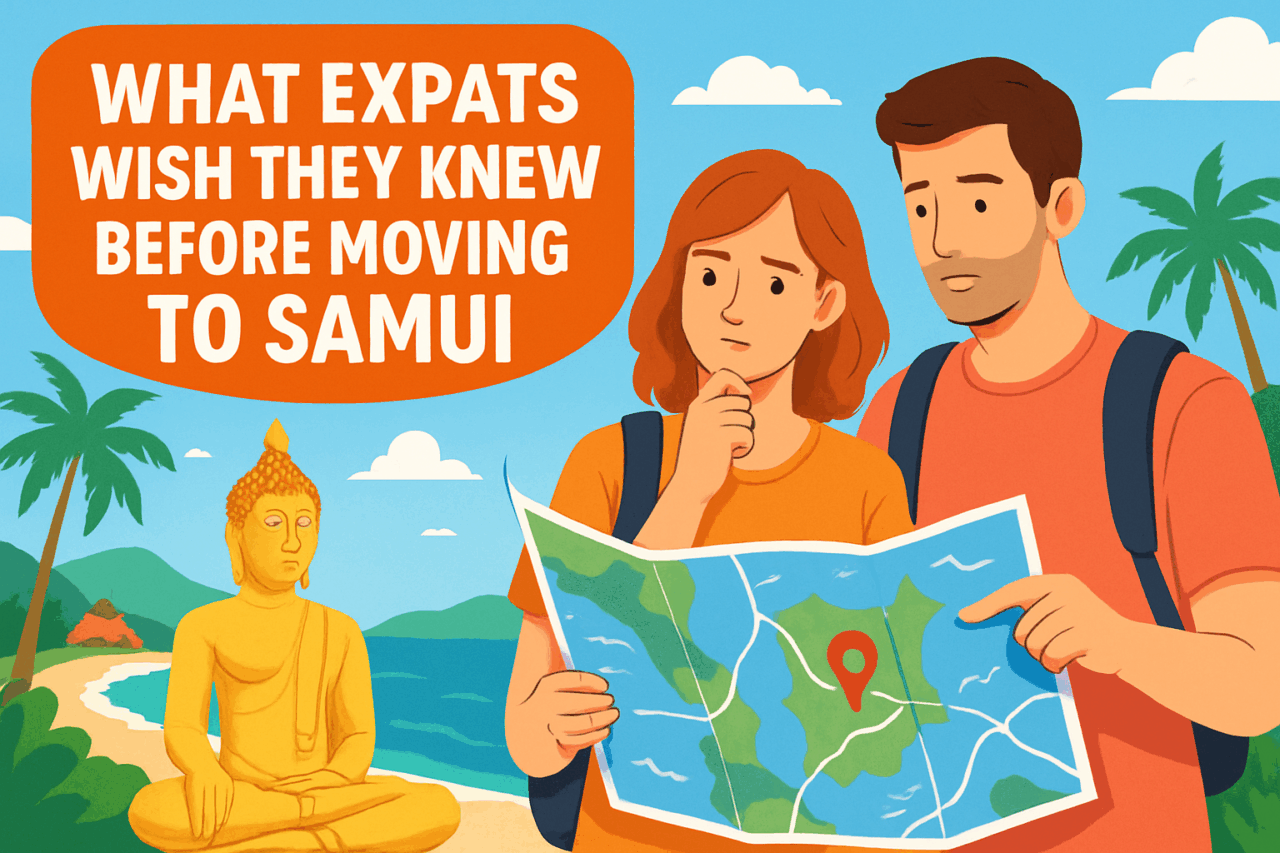What Expats Wish They Knew Before Moving to Koh Samui
By Tsvetomir
Ah, Koh Samui! Picture yourself stepping off a ferry, the scent of frangipani in the air, the sea breeze tousling your hair, and a horizon alive with coconut palms. I still remember my first sunset here, when the sky blushed pink over the Big Buddha, and I thought, “Why didn’t I come sooner?” If you’re dreaming of trading your daily grind for island life, let me be your guide to the things expats wish they’d known before making Samui their home.
The Realities of Island Life: Beyond the Brochures
Koh Samui glows in travel magazines, but living here is a different rhythm. The island is a vibrant mosaic of sleepy fishing villages, bustling beach towns, and lush jungle hills. Each neighborhood has its own flavor: Chaweng (map), with its lively nightlife and white sands; Lamai (map), a relaxed blend of old-school Samui and modern comforts; or Maenam (map), where tranquility rules and sunsets steal the show.
But here’s the twist: paradise isn’t always perfect. Power outages can happen during storms (keep a torch and a good book handy!). Internet speeds can vary wildly by neighborhood. My advice? Before signing a long-term lease, spend a week or two in different areas to get a feel for the vibe and the Wi-Fi.
Finding Your New Home: From Beach Huts to Hilltop Villas
The rental market in Samui is as diverse as the island’s cuisine. You can wake up to the sound of waves in a simple beach bungalow or watch the sunrise from a modern villa tucked in the hills above Bophut (map). The catch? Quality—and prices—vary dramatically. Photos online may be a decade old, and “ocean view” can mean binoculars required.
- Tip: Always visit in person before committing. If you’re here during the rainy season (October–December), you’ll see how your potential home handles downpours (leaky roofs are a rite of passage).
- Off-the-beaten-path gem: Try the lush inland area around Ban Tai (map). Fewer tourists, friendlier rents, and a true sense of community.
Getting Around: Scooters, Songthaews, and Samui Traffic
The scooter is king here. With the wind in your hair and the road unwinding before you, it’s easy to fall in love with two wheels. But take care—Samui’s roads can be slippery after rain, and the island’s hills are not for the faint-hearted. Helmets aren’t just for tourists!
- Tip: If you’re new to scooters, start slow. Practice in quieter areas like Maenam or Bang Por (map).
- No scooter? Hop on a songthaew (shared red truck taxis), which run set routes between towns. The drivers have stories as colorful as their vehicles—ask about the best local eats, and you’ll never go hungry.
Shopping & Markets: Where to Find What You Need
Forget Western supermarkets; the heart of Samui beats in its markets. The Friday night market in Fisherman’s Village (map), with its lantern-lit stalls and sizzling street food, is a feast for the senses. For fresh produce, try Lamai Fresh Market (map). If you crave a taste of home, Big C (map) and Makro (map) stock imported goods (though be prepared for a little sticker shock on your favorite cheeses).
- Hidden gem: The tiny, unassuming Ban Hua Thanon Market (map) is a source for the freshest seafood—and the friendliest aunties on the island.
Healthcare: Sunburns, Sea Urchins, and Samui Hospitals
Rest easy: Samui boasts several international-standard hospitals, including Bangkok Hospital Samui (map) and Samui International Hospital (map). For minor aches (or the legendary Samui sunburn), local clinics are both efficient and affordable.
- Tip: Invest in a good international health insurance plan. Tropical adventures sometimes come with tropical mishaps (ask me about my run-in with a sea urchin…).
Community & Culture: Finding Your Tribe
Samui’s expat community is a patchwork quilt of digital nomads, retirees, young families, and intrepid entrepreneurs. The best way to meet people? Join a beach clean-up, a yoga class at The Yogarden (map), or a language exchange at a local café. Thais are famously friendly—learn a little Thai, and doors (and hearts) will open.
- Off-the-beaten-path experience: The Buddhist temple at Wat Plai Laem (map), with its serene lake and intricate statues, is not just for tourists. Visit at sunrise for quiet reflection and a chance to chat with the resident monks.
Weather: The Good, the Bad, and the Monsoon
Samui’s weather is a symphony of sun, with a dramatic monsoon crescendo from October to December. It’s rarely cold, but humidity is a loyal companion. Invest in a good fan, embrace afternoon siestas, and keep your sense of humor about the occasional downpour (it’s just the tropics reminding you who’s boss).
Final Thoughts: Embrace the Island’s Quirks
Moving to Koh Samui is a leap into the unknown, equal parts adventure and adjustment. There will be days when the geckos in your house outnumber your socks, when you crave a decent bagel, or when a sudden rainstorm turns your street into a river. But Samui’s magic is in these moments—the laughter, the resilience, the sense of community that grows faster than the island’s coconut palms.
So pack your curiosity, your patience, and an open heart. Samui isn’t just a place to live—it’s a place to belong. See you on the beach at sunset.
Have questions? Drop them in the comments below, and I’ll point you to my favorite noodle shop or secret swimming cove. Sawasdee, friends!

Comments (0)
There are no comments here yet, you can be the first!